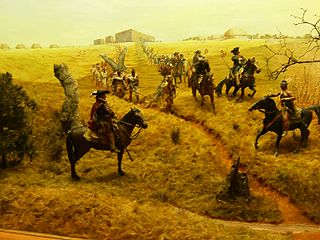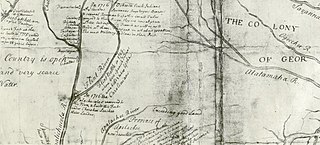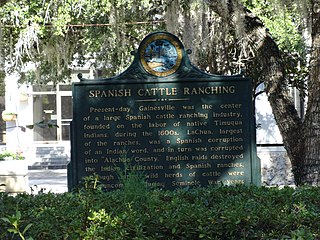Related Research Articles
The Yamasees were a multiethnic confederation of Native Americans who lived in the coastal region of present-day northern coastal Georgia near the Savannah River and later in northeastern Florida. The Yamasees engaged in revolts and wars with other native groups and Europeans living in North America,specifically from Florida to North Carolina.

Spanish Florida was the first major European land-claim and attempted settlement-area in northern America during the European Age of Discovery. La Florida formed part of the Captaincy General of Cuba,the Viceroyalty of New Spain,and the Spanish Empire during Spanish colonization of the Americas. While its boundaries were never clearly or formally defined,the territory was initially much larger than the present-day state of Florida,extending over much of what is now the southeastern United States,including all of present-day Florida plus portions of Georgia,South Carolina,North Carolina,Alabama,Mississippi,and the Florida Parishes of Louisiana. Spain based its claim to this vast area on several wide-ranging expeditions mounted during the 16th century. A number of missions,settlements,and small forts existed in the 16th and to a lesser extent in the 17th century;they were eventually abandoned due to pressure from the expanding English and French colonial settlements,the collapse of the native populations,and the general difficulty in becoming agriculturally or economically self-sufficient. By the 18th century,Spain's control over La Florida did not extend much beyond a handful of forts near St. Augustine,St. Marks,and Pensacola,all within the boundaries of present-day Florida.

Mission San Luis de Apalachee was a Spanish Franciscan mission built in 1656 in the Florida Panhandle,two miles west of the present-day Florida Capitol Building in Tallahassee,Florida. It was located in the descendent settlement of Anhaica capital of Apalachee Province. The mission was part of Spain's effort to colonize the Florida Peninsula and to convert the Timucuan and Apalachee Indians to Christianity. The mission lasted until 1704 when it was evacuated and destroyed to prevent its use by an approaching militia of Creek Indians and South Carolinians.

The Apalachee massacre was a series of raids by English colonists from the Province of Carolina and their Muscogee allies against a largely peaceful Apalachee population in northern Spanish Florida which took place in January 1704 during Queen Anne's War. Against limited Spanish and Apalachee resistance,a network of Catholic missions was destroyed by the raiders;most of their population were either killed,captured,fled to larger Spanish and French outposts,or voluntarily joined the English.
Apalachicola Province was a group or association of towns located along the lower part of the Chattahoochee River in present-day Alabama and Georgia. The Spanish so called it because they perceived it as a political entity under the leadership of the town of Apalacicola. It is believed that before the 17th century,the residents of all the Apalachicola towns spoke the Hitchiti language,although other towns whose people spoke the Muscogee language relocated among the Apalachicolas along the Chattahoochee River in the middle- to later- 17th century. All of the Apalachicola towns moved to central Georgia at the end of the 17th century,where the English called them "Ochese Creek Indians". They moved back to the Chattahoochee River after 1715,with the English then calling them "Lower Creeks",while the Spanish called them "Ochese".
Ahaya was the first recorded chief of the Alachua band of the Seminole tribe. European-Americans called him Cowkeeper,as he held a very large herd of cattle. Ahaya was the chief of a town of Oconee people near the Chattahoochee River. Around 1750 he led his people into Florida where they settled around Payne's Prairie,part of what the Spanish called tierras de la chua,"Alachua Country" in English. The Spanish called Ahaya's people cimarones,which eventually became "Seminoles" in English. Ahaya fought the Spanish,and sought friendship with the British,allying with them after Spain ceded Florida to Great Britain in 1763,and staying loyal to them through the American Revolutionary War. He died shortly after Britain returned Florida to Spain in 1783.
Juan Francisco Buenaventura de Ayala y Escobar was a prominent Spanish soldier and administrator who governed Spanish Florida from October 30,1716,to August 3,1718. The succeeding governor,Antonio de Benavides,a zealous reformer,accused Ayala of trading in contraband with the English,and had him arrested and briefly jailed in the Castillo de San Marcos of St. Augustine. He was eventually exiled to Cuba,where he died in 1727,before he was exonerated and all charges dropped in 1731.

Antonio Benavides Bazán y Molina was a Lieutenant General in the Spanish Army who held administrative positions in the Americas as Royal Governor of Spanish Florida (1718–1734),Governor of Veracruz (1734–1745),Governor and Captain General of Yucatán province,as well as Governor of Manila in the Philippines. Before his successive appointments to these various positions,he served with distinction in several campaigns of the War of the Spanish Succession in 1710,and perhaps saved the life of Philip V,the first Bourbon King of Spain,at Guadalajara.
Francisco de Córcoles y Martínez was a Spanish military officer who served as governor of Spanish Florida,an office he occupied from 1706 to 1716.
Luis Benedit y Horruytiner was a Spanish colonial administrator who held office as governor of Spanish Florida,and viceroy of Sardinia. He was the uncle of Pedro Benedit Horruytiner,who succeeded him as governor of La Florida.

The Battle of Flint River,also called the Spanish-Indian Battle (1702) or the Battle of the Blankets,was a failed attack by Spanish and Apalachee Indian forces against Creek Indians in October 1702 in what is now the state of Georgia. The battle was a major element in ongoing frontier hostilities between English colonists from the Province of Carolina and Spanish Florida,and it was a prelude to more organized military actions of Queen Anne's War.

The siege of Pensacola included two separate attempts in 1707 by English-supported Creek Indians to capture the town and fortress of Pensacola,one of two major settlements in Spanish Florida.
Diego de Rebolledo y Suárez de Aponte,was the 21st colonial governor of Spanish Florida,in office from June 18,1654 to February 20,1659. He is considered by historians to be one of the more controversial governors of Spanish colonial Florida. Rebolledo showed a marked lack of respect for the status of the Timucua chiefs as hereditary leaders and administrative intermediaries,an attitude that provoked a Timucuan uprising against Spanish rule. Rebolledo was a Knight of the Order of Santiago.
Francisco Menéndez Márquez y Posada was a royal treasurer and interim co-governor of Spanish Florida,and the founder of a cattle ranching enterprise that became the largest in Florida.
Juan Fernández de Olivera was the governor of Spanish Florida from 1610 to November 23,1612. He died in office.
Damián de Vega Castro y Pardo was the governor of the Spanish province of La Florida from November 26,1638 to April 10,1645.

Cattle ranching was an important industry in Spanish Florida in the second half of the seventeenth century. The Spanish were in Florida for almost a century before ranching became widespread in the colony. Late in the seventeenth century,ranches were located along the middle St. Johns River,in Potano Province,and in Apalachee Province. Ranches flourished despite conflicts with the native people of Florida. Attacks by the English colony,the Province of Carolina,and its native allies brought an abrupt end to ranching in Florida at the beginning of the eighteenth century.
Sabacola was a Native American tribal town in what is now the Southeastern United States of America during the 17th,18th,and early 19th centuries. Usually regarded as belonging to Apalachicola Province,Sabacola had poorly understood connections to the Apalachee people. Although usually described as speaking the Hitchiti language,at least one source stated that the Sabacola spoke another,unidentified language. The town moved to several locations along the Chattahoochee River,sometimes with more than one town including Sabacola in its name at the same time. The town of Sabacola moved to the Ocmulgee River area of central Georgia for about 25 years,before returning to the Chattahoochee River. Sabacola was the only Apalachicola town to have a mission established by the Spanish. The Apalachicola towns,including Sabacola,evolved into the Lower Towns of the Muscogee Confederacy.
Apalachicola was a tribal town in the Apalachicola Province in the 17th century,located on the lower part of the Chattahoochee River in what is now Alabama and Georgia. The residents of the town spoke the Hitchiti language. The town of Apalachicola moved to the Savannah River in the early 1690s,when the other towns in Apalachicola Province moved to central Georgia,primarily to sites along the Ocmulgee River. In 1715,Apalachicola moved back to the Chattahoochee River along with the towns that had been on the Ocmulgee River,with the English then calling them "Lower Creeks",while the Spanish called them "Ochese". The town of Apalachicola continued as part of the Lower Towns through the 18th century.
Oconee was a tribal town of Hitchiti-speaking Indigenous peoples of the Southeastern Woodlands during the 17th and 18th centuries.
References
- ↑ Mark F. Boyd (July 1949). "Diego Pena' s Expedition to Apalachee and Apalachicolo in 1716". Florida Historical Quarterly. XXVIII (1). Florida Historical Society: 5. Retrieved 9 August 2016.
- ↑ John Worth (2016). "The Governors of Colonial Florida, 1565-1821". UWF.edu. Pensacola, Florida: University of West Florida. Archived from the original on January 30, 2016. Retrieved 8 August 2016.
- 1 2 Paul Eugen Camp (2001). "Conquistadores in the land of flowers a chronology of Spanish Florida 1513 to 1821". usf.edu. Tampa: Special Collections Dept., University of South Florida Library. Archived from the original on May 19, 2016. Retrieved 9 August 2016.
- ↑ Steven C. Hahn (2004). The Invention of the Creek Nation, 1670-1763. U of Nebraska Press. p. 96. ISBN 0-8032-2414-1.
- ↑ Mark F. Boyd (July 1949). "Diego Pena' s Expedition to Apalachee and Apalachicolo in 1716". Florida Historical Quarterly. XXVIII (1). Florida Historical Society: 5. Retrieved 9 August 2016.